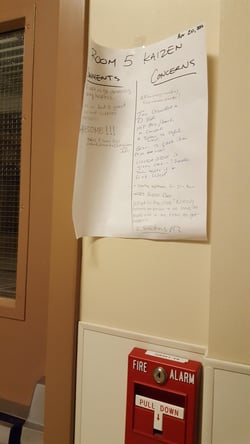 A friend who knows that I am interested in continuous improvement techniques of all sorts was visiting a relative in the ER in a California hospital. She sent me this photo. If you are a frequent reader of this blog, you probably know why this upset me, but I think it is worth listing the reasons it made me cringe.
A friend who knows that I am interested in continuous improvement techniques of all sorts was visiting a relative in the ER in a California hospital. She sent me this photo. If you are a frequent reader of this blog, you probably know why this upset me, but I think it is worth listing the reasons it made me cringe.
Listen to the post (subscribe to our podcast):
My friend didn’t go on some covert operation to find this sign. It was in a public area at the end of the emergency department hallway. Although nothing on it was particularly damaging, some would consider it risky to share this type of information with customers. Certainly, customers can be involved in improvement work, but does that make the employees less likely to be honest about their suggestions?
I asked our VP of Improvement and Innovation Services Mark Graban about this and he said, "Some health systems definitely keep Kaizen ideas private, in a break room or private hallway. But a growing number of hospitals are comfortable with the transparency, as it sends a message that improvement is happening."
I'd add, though, If the hospital had opted for a digital approach to improvement, employees could add suggestions on their mobile devices right from the ER without exposing the information to patients.
So what are some of the problems with the board?
It Seems Very Temporary
If this board is a representation of how much leadership cares about improvement, it isn’t much. I can’t imagine an employee looking at this sheet of paper and getting excited about contributing to positive change. Smart leaders understand that the level of investment they make into the tools of improvement sends a signal to the organization that Kaizen matters and will be supported.
Putting a piece of paper on the wall implies that this was a one-off exercise, as opposed to creating an ongoing culture of continuous improvement. Even a bulletin board or whiteboard would make this look more permanent (since improvement is never ending). Choosing an improvement software system would send a similar message :-)
It Appears to Have Been Neglected
This photo was taken on January 27, 2017. The date on the board is April 20, 2016. Yup, it was a one-off effort.
The “Concerns” part of the document is all filled up. I don’t know if that happened on the first day it was posted, but it seems unlikely that all of these thoughts were recently submitted. Even if they were, where does the next concern go? What is being implemented? Are leaders engaging people in ongoing discussions about opportunities for improvement?
Or, is this an example of a place where good ideas go to die?
It Doesn't Demonstrate Good Problem Solving
A board with vague headers like "Comments" and "Concerns" (as we see on this board) might just collect a bunch of suggestions. That was one of the problems with the suggestion box approach...people jump to solutions. Lean organizations focus on not jumping to solutions. An effective continuous improvement approach doesn't just collect problems and also doesn't just collect random ideas. There should be a good pairing of problems (or opportunities) and solutions (or ideas or countermeasures). For each problem, the team should brainstorm possible solutions. For each idea, leaders should coach and ask, "What problem is that trying to solve?"
It Isn’t Designed for Action and Real Improvement
This Kaizen board has all of the drawbacks of a physical suggestion box. Ideas go up, but then what? Was anything ever done about these concerns? The board doesn't shed any light. It doesn’t assign ownership, provide for a plan of action, track progress or report results. An effective Kaizen board (physical or digital) does all of this and ensures that progress is maintained with notifications and alerts. We applaud the impulse to gather employee ideas for improvement, but collecting ideas is only the first step in an effective improvement approach.
We didn’t share this to pick on this particular hospital, but rather to illustrate that it matters a lot how improvement techniques are implemented. If your Kaizen board looks like this one, please know that there is a better way.


Add a Comment